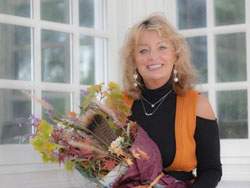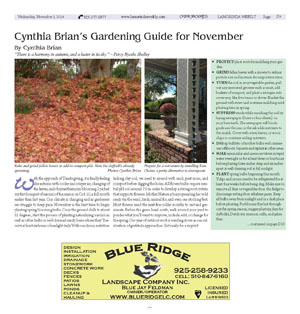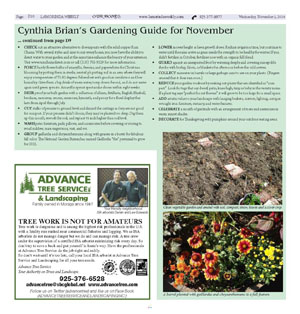|
|
Published November 5th, 2014
|
Cynthia Brian's Gardening Guide for November
|
| "There is a harmony in autumn, and a luster in its sky." - Percy Bysshe Shelley |
| By Cynthia Brian |
 |
| Rake and grind fallen leaves to add to compost pile. Note the daffodils already sprouting. Photos Cynthia Brian |
With the approach of Thanksgiving, it is finally feeling like autumn with cooler and crisper air, changing of the leaves, and chrysanthemums blooming. I picked my first bouquet of narcissi of the season on Oct. 10, a full month earlier than last year. Our climate is changing and as gardeners we struggle to keep pace. November is the best time to begin planting spring blooming bulbs. Once the ground chills to about 55 degrees, start the process of planting naturalizing narcissi as well as other bulbs in well-drained sandy loam where they'll receive at least six hours of sunlight daily. With our dense, nutrition lacking clay soil, we need to amend with sand, peat moss, and compost before digging the holes. All flower bulbs require neutral pH soil around 7.0 in order to develop a strong root system that supports flowers. Mother Nature is busy spreading her wild seeds via the wind, birds, animal fur, and even our stocking feet. Most flowers need the next few colder months to rest and germinate. Before the geese head south, walk around your yard to ponder what you'll want to improve, include, edit, or change for the spring. Our year of outdoor work is winding down as our celebration of gratitude approaches. Get ready for a respite!
 � PROTECT plant roots by mulching your garden.
� PROTECT plant roots by mulching your garden.
 � GRIND fallen leaves with a mower to reduce particle size and increase decomposition time.
� GRIND fallen leaves with a mower to reduce particle size and increase decomposition time.
 � TURN the soil in your vegetable garden, pull out any unwanted growers such as mint, add buckets of compost, and plant a nitrogen-rich cover crop like fava beans or clover. Blanket the ground with straw and continue mulching until planting time in spring.
� TURN the soil in your vegetable garden, pull out any unwanted growers such as mint, add buckets of compost, and plant a nitrogen-rich cover crop like fava beans or clover. Blanket the ground with straw and continue mulching until planting time in spring.
 � SUPPRESS weeds while enriching the soil by laying newspaper (three or four sheets) on your bare earth. The newspaper will biodegrade and the zinc in the ink adds nutrients to the mulch. Cover with straw, leaves, or wood chips to continue adding nutrients.
� SUPPRESS weeds while enriching the soil by laying newspaper (three or four sheets) on your bare earth. The newspaper will biodegrade and the zinc in the ink adds nutrients to the mulch. Cover with straw, leaves, or wood chips to continue adding nutrients.
 � DIG up bulblets of mother bulbs with numerous offshoots. Separate and replant in other areas.
� DIG up bulblets of mother bulbs with numerous offshoots. Separate and replant in other areas.
 � SOAK ranunculus and anemone tubers in tepid water overnight or for at least three or four hours before planting three inches deep and six inches apart in well-draining soil in full sunlight.
� SOAK ranunculus and anemone tubers in tepid water overnight or for at least three or four hours before planting three inches deep and six inches apart in well-draining soil in full sunlight.
 � PLANT spring bulbs beginning this month. Tulips and crocus need to be refrigerated for at least four weeks before being dug. Make sure to remove all fruit or vegetables from the fridge to discourage rotting from ethylene gases. Keep all bulbs away from sunlight and in a dark place before planting. For blooms that last throughout the spring season, stagger planting days for daffodils, Dutch iris, muscari, scilla, and galanthus.
� PLANT spring bulbs beginning this month. Tulips and crocus need to be refrigerated for at least four weeks before being dug. Make sure to remove all fruit or vegetables from the fridge to discourage rotting from ethylene gases. Keep all bulbs away from sunlight and in a dark place before planting. For blooms that last throughout the spring season, stagger planting days for daffodils, Dutch iris, muscari, scilla, and galanthus.
 � CHECK out an attractive alternative to downspouts with the solid copper Rain Chains. With several styles and sizes to suit every home, you now have the ability to direct water to your garden and at the same time enhance the beauty of your exteriors. Visit www.rainchainsdirect.com or call (310) 702-9529 for more information.
� CHECK out an attractive alternative to downspouts with the solid copper Rain Chains. With several styles and sizes to suit every home, you now have the ability to direct water to your garden and at the same time enhance the beauty of your exteriors. Visit www.rainchainsdirect.com or call (310) 702-9529 for more information.
 � FORCE hardy flower bulbs of amaryllis, freesias, and paperwhites for Christmas blooming by potting them in sterile, neutral pH potting soil in an area where they will enjoy a temperature of 72-82 degrees Fahrenheit with good air circulation and low humidity. Give them a big drink of warm water, tamp down the soil, and do not water again until green sprouts. Amaryllis sprout spectacular shows within eight weeks.
� FORCE hardy flower bulbs of amaryllis, freesias, and paperwhites for Christmas blooming by potting them in sterile, neutral pH potting soil in an area where they will enjoy a temperature of 72-82 degrees Fahrenheit with good air circulation and low humidity. Give them a big drink of warm water, tamp down the soil, and do not water again until green sprouts. Amaryllis sprout spectacular shows within eight weeks.
 � DEER proof your bulb garden with a collection of allium, fritillaria, English Bluebell, brodiaea, narcissus, crocus, anemone, hyacinth, and peony for a floral display that lasts from April through July.
� DEER proof your bulb garden with a collection of allium, fritillaria, English Bluebell, brodiaea, narcissus, crocus, anemone, hyacinth, and peony for a floral display that lasts from April through July.
 � CUT stalks of peonies to ground level and discard the cuttings as they are not good for compost. If your peonies didn't bloom, they may be planted too deep. Dig them up this month, rework the soil, and replant 1/2 inch higher than soil level.
� CUT stalks of peonies to ground level and discard the cuttings as they are not good for compost. If your peonies didn't bloom, they may be planted too deep. Dig them up this month, rework the soil, and replant 1/2 inch higher than soil level.
 � WASH patio furniture, pads, pillows, and accessories before covering or storing to avoid mildew, mice migrations, rust, and rot.
� WASH patio furniture, pads, pillows, and accessories before covering or storing to avoid mildew, mice migrations, rust, and rot.
 � GROUP gaillardia and chrysanthemums along with grasses in a barrel for fabulous fall color. The National Garden Bureau has named Gaillardia "the" perennial to grow for 2015.
� GROUP gaillardia and chrysanthemums along with grasses in a barrel for fabulous fall color. The National Garden Bureau has named Gaillardia "the" perennial to grow for 2015.
 � LOWER mower height as lawn growth slows. Reduce irrigation time, but continue to water until the rains arrive as grass needs the strength to be healthy for winter. If you didn't fertilize in October, fertilizer now with an organic fall blend.
� LOWER mower height as lawn growth slows. Reduce irrigation time, but continue to water until the rains arrive as grass needs the strength to be healthy for winter. If you didn't fertilize in October, fertilizer now with an organic fall blend.
 � GUARD against an unexpected frost by watering deeply and covering susceptible shrubs with burlap, fabric, or blankets the afternoon before the cold arrives.
� GUARD against an unexpected frost by watering deeply and covering susceptible shrubs with burlap, fabric, or blankets the afternoon before the cold arrives.
 � COLLECT rainwater in barrels or large garbage cans to use on your plants. (Fingers crossed that it does rain soon.)
� COLLECT rainwater in barrels or large garbage cans to use on your plants. (Fingers crossed that it does rain soon.)
 � REDUCE your garden workout by seeking out plants that are identified as "compact." Look for tags that say dwarf, patio, knee-high, tiny, or baby in the variety name. If a plant tag says "perfect for cut flowers" it will grow to be too large for a small space.
� REDUCE your garden workout by seeking out plants that are identified as "compact." Look for tags that say dwarf, patio, knee-high, tiny, or baby in the variety name. If a plant tag says "perfect for cut flowers" it will grow to be too large for a small space.
 � ADD artistic value to your landscape with hanging baskets, mirrors, lighting, antique wrought iron furniture, statuary, and water features.
� ADD artistic value to your landscape with hanging baskets, mirrors, lighting, antique wrought iron furniture, statuary, and water features.
 � CELEBRATE a month of gratitude with an arrangement of roses and anemones in warm sunset shades.
� CELEBRATE a month of gratitude with an arrangement of roses and anemones in warm sunset shades.
 � DECORATE for Thanksgiving with pumpkins around your outdoor seating areas.
� DECORATE for Thanksgiving with pumpkins around your outdoor seating areas.

|
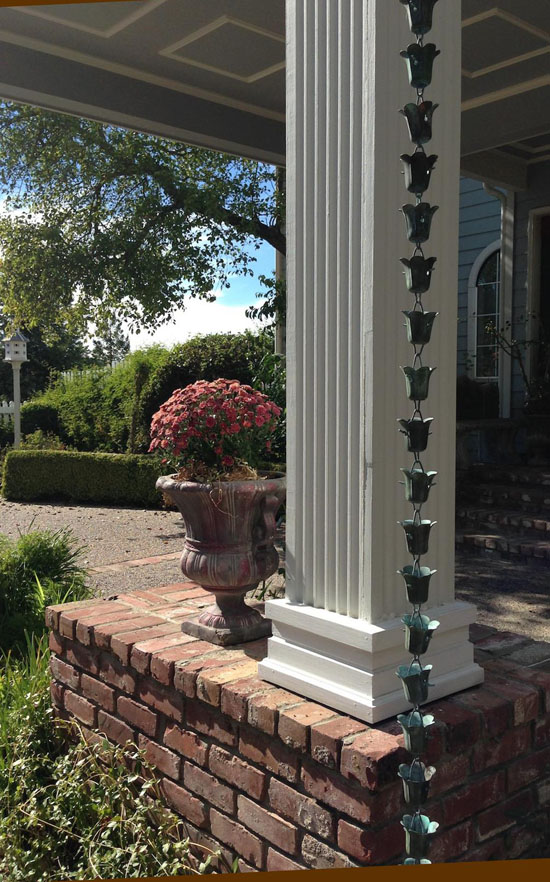 |
| Prepare for a wet winter by installing Rain Chains, a pretty alternative to downspouts. |
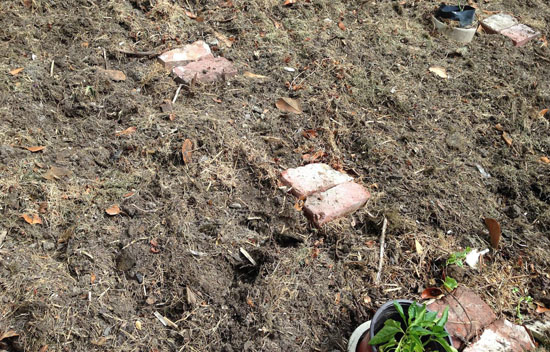 |
| Clean vegetable garden and amend with soil, compost, straw, leaves and a cover crop. |
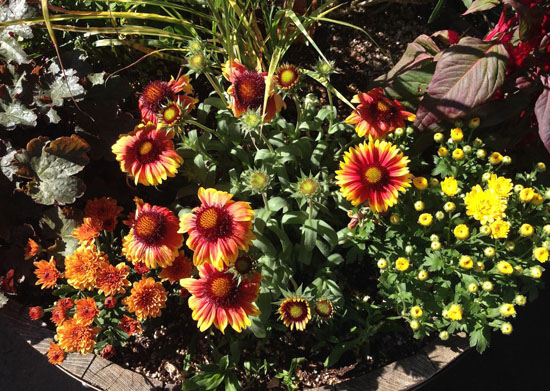 |
| A barrel planted with gaillardia and chrysanthemums is a fall feature. |
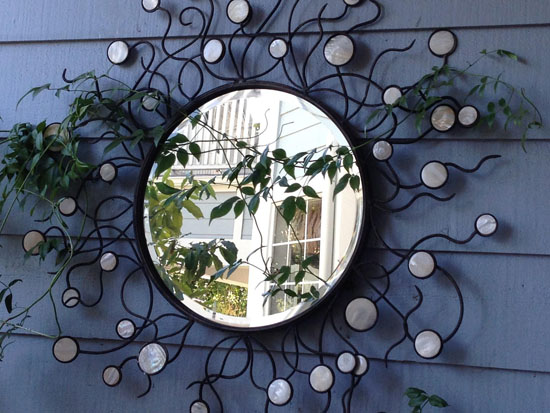 |
| Get creative with your outdoor space by hanging a mirror and twine a vine around it. |
 |
| Wash patio furniture before covering or storing. |
|
|
|

